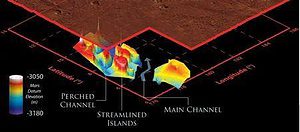Our understanding and appreciation of Mars has greatly shifted in the past decade alone. If previously scientists used to thought the planet had been dead and bared geologically-wise for billions of years, recent evidence shows that Mars has been marked by a series of geological events. Using radar technology, scientists have now found water-carved channels buried beneath the Red Planet’s surface that are believed to have been generated by a megaflood.
Today Mars is as dead – a cold and dry planet that’s only a shallow image of its once glorious self. Billions of years ago, the planet was crossed by channels and rivers of flowing water and had a much thicker atmosphere than today. The largest river system is 600 mile-long Marte Vallis system, which lies in Elysium Planitia, an expanse of plains along the Martian equator.
Coincidence or not this area is the youngest volcanic region on Mars, riddled with evidence of once massive amounts of flowing lava, hiding a lot of the feature’s planets, including important portions of the Marte Vallis, like its origin, which most likely was a lot longer than its current pathetic remnants.
Using the Mars Reconnaissance Orbiter, scientists at NASA’s Goddard Space Flight Center and the Jet Propulsion Laboratory have used the orbiting spacecraft’s shallow Radar (SHARAD) instrument to peer through the Elysium Planitia surface. This allowed a 3-D reconstruction of the Marte Vallis, revealing a number of features previously obscured by ancient lava deposits.
“This is the first time we’ve been able to see buried flood channels on a planet other than the Earth,” lead study author Gareth Morgan, a geologist at the Smithsonian’s National Air and Space Museum.
What they found was staggering – both the headwaters and floodplain of the river had been covered by lava from a volcanic eruption no more than 500 million years ago. Two different phases of channel formation were observed: one phase etched a series of smaller branching channels that are now on a raised ‘bench’ next to the main channel, the other phase carved the deep, wide channels.
“In this region, the radar picked up multiple ‘reflectors,’ which are surfaces or boundaries that reflect radio waves, so it was possible to see multiple layers, ” says Lynn Carter of NASA’s Goddard Space Flight Center. “We have rarely seen that in SHARAD data outside of the polar ice regions of Mars.”
Moreover, the researchers found the channels of Marte Vallis were at least 230 feet (70 meters) deep, making them at least twice as deep as previously thought.
“That shows previous ideas of erosion, of how much water have gone through Marte Vallis, have been underestimated,” Morgan said. “There was more significant flooding than before thought, and it’s interesting to think of where this water might have come from during this relatively dry period.”
This megaflood is likened by the researchers with the Missoula outpourings of some 15,000 years ago in the Pacific Northwest, which flooded the large areas of what is now Washington and Oregon, after an ice dam at the glacial Lake Missoula broke. The huge 200-mile-long lake would have likely drained within 48 hours.
A similar event on Mars, on a much larger scale, would have most likely led to climate change, and by studying them researchers only deepen their understanding of both ancient and contemporary Martian climate. Still, it’s rather remarkable how much we’ve learned in the past few years about Mars watery history and how much still remains to be uncovered. For instance, just a few weeks ago ZME Science reported on ESA’s remarkable discovery of Mars’ longest river found thus far, the 1,000 miles long Reull Vallis.
The findings were detailed in a paper published in the journal Science.











